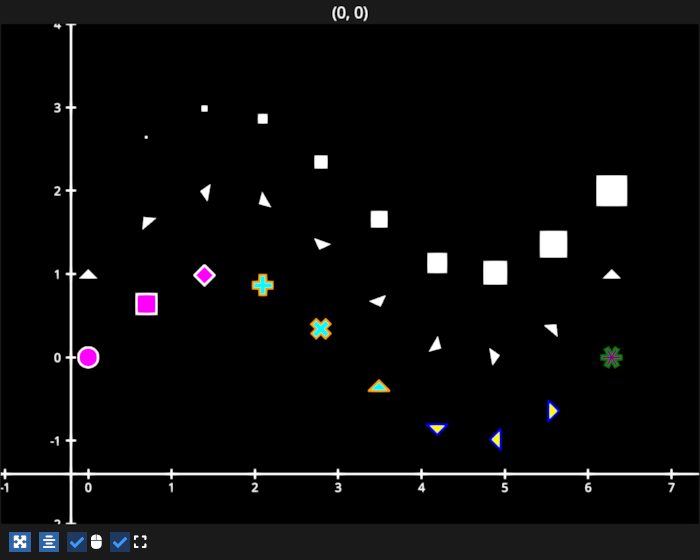Note
Go to the end to download the full example code.
Scatter validation#
Example that shows some scatter plot features for test validation.

/home/runner/work/fastplotlib/fastplotlib/fastplotlib/graphics/features/_base.py:18: UserWarning: casting float64 array to float32
warn(f"casting {array.dtype} array to float32")
# test_example = true
import numpy as np
import fastplotlib as fpl
import imageio.v3 as iio
xs = np.linspace(0, 2 * np.pi, 10)
# make sine and cosine data
sine = np.column_stack([xs, np.sin(xs)])
cosine = np.column_stack([xs, np.cos(xs)])
# a simple image to display as the points
array = np.array([
[1, 0, 1],
[0, 1, 0],
[1, 1, 1],
])
# load an image of Almar's cat
wikkie = np.flipud(iio.imread("imageio:wikkie.png"))
figure = fpl.Figure(
size=(700, 560)
)
figure[0, 0].add_scatter(sine)
# combinations of per-point markers, colors and edge colors
figure[0, 0].add_scatter(
sine,
colors=["magenta"] * 3 + ["cyan"] * 3 + ["yellow"] * 3 + ["purple"],
uniform_edge_color=False,
edge_colors=["w"] * 3 + ["orange"] * 3 + ["blue"] * 3 + ["green"],
markers=list("osD+x^v<>*"),
edge_width=2.0,
sizes=20,
uniform_size=True,
)
# per-point rotations
figure[0, 0].add_scatter(
sine,
markers="^",
sizes=20,
point_rotation_mode="vertex",
point_rotations=xs,
uniform_size=True,
offset=(0, 1, 0)
)
# point sizes
figure[0, 0].add_scatter(
sine,
markers="s",
sizes=xs * 5,
offset=(0, 2, 0)
)
figure.show()
# NOTE: fpl.loop.run() should not be used for interactive sessions
# See the "JupyterLab and IPython" section in the user guide
if __name__ == "__main__":
print(__doc__)
fpl.loop.run()
Total running time of the script: (0 minutes 0.642 seconds)
